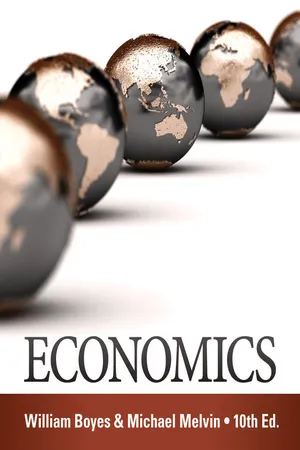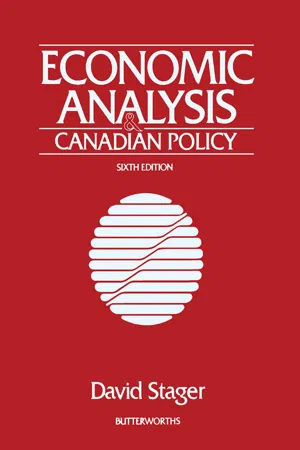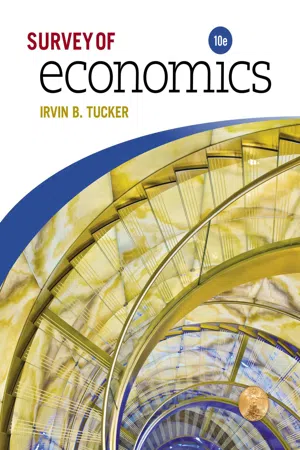Marketing
PED and YED
PED (Price Elasticity of Demand) measures the responsiveness of quantity demanded to a change in price. If PED is greater than 1, demand is considered elastic; if less than 1, demand is inelastic. YED (Income Elasticity of Demand) measures the responsiveness of quantity demanded to a change in income. A positive YED indicates a normal good, while a negative YED indicates an inferior good.
Written by Perlego with AI-assistance
Related key terms
1 of 5
10 Key excerpts on "PED and YED"
- No longer available |Learn more
- (Author)
- 2014(Publication Date)
- Orange Apple(Publisher)
____________________ WORLD TECHNOLOGIES ____________________ Chapter- 3 Price Elasticity of Demand PED is derived from the percentage change in quantity (%ΔQ d ) and percentage change in price (%ΔP). Price elasticity of demand ( PED or E d ) is a measure used in economics to show the responsiveness, or elasticity, of the quantity demanded of a good or service to a change in its price. More precisely, it gives the percentage change in quantity demanded in response to a one percent change in price (holding constant all the other determinants of demand, such as income). It was devised by Alfred Marshall. Price elasticities are almost always negative, although analysts tend to ignore the sign even though this can lead to ambiguity. Only goods which do not conform to the law of demand, such as Veblen and Giffen goods, have a positive PED. In general, the demand for a good is said to be inelastic (or relatively inelastic ) when the PED is less than one (in absolute value): that is, changes in price have a relatively small effect on the quantity of the good demanded. The demand for a good is said to be elastic (or relatively elastic ) when its PED is greater than one (in absolute value): that is, changes in price have a relatively large effect on the quantity of a good demanded. Revenue is maximised when price is set so that the PED is exactly one. The PED of a good can also be used to predict the incidence (or burden) of a tax on that good. ____________________ WORLD TECHNOLOGIES ____________________ Various research methods are used to determine price elasticity, including test markets, analysis of historical sales data and conjoint analysis. Definition PED is a measure of responsiveness of the quantity of a good or service demanded to changes in its price. - eBook - PDF
- William Boyes, Michael Melvin(Authors)
- 2015(Publication Date)
- Cengage Learning EMEA(Publisher)
He found that not only had ticket sales declined, but his revenue had fallen as well. Where had the manager gone wrong? 1. How much do buyers alter their purchases in response to a price change? 434 Chapter 20 Elasticity: Demand and Supply Copyright 2016 Cengage Learning. All Rights Reserved. May not be copied, scanned, or duplicated, in whole or in part. Due to electronic rights, some third party content may be suppressed from the eBook and/or eChapter(s). Editorial review has deemed that any suppressed content does not materially affect the overall learning experience. Cengage Learning reserves the right to remove additional content at any time if subsequent rights restrictions require it. 20-1a The Definition of Price Elasticity Elasticity is the measure of the responsiveness of quantity demanded or quantity supplied to a change in price or some other important variable . By “responsiveness” we mean “how much quantity demanded or quantity supplied changes with respect to a change in one variable, everything else held constant.” We have measures of elasticity for both demand and supply. The price elasticity of demand is a measure of the magnitude by which consumers alter the quantity of some product that they purchase in response to a change in the price of that product. The price elasticity of demand, symbolized as e d , is the percentage change in the quan-tity demanded of a product divided by the percentage change in the price of that product. e d ¼ % D Q D % D P The more price-elastic demand is, the more responsive consumers are to a price change—that is, the more they will adjust their purchases of a product when the price of that product changes. Conversely, the less price-elastic demand is, the less responsive consumers are to a price change. Demand curves typically slope down. This means that price ( P ) and quantity ( Q D ) demanded move in opposite directions. Whenever P falls, Q D rises, and when P rises Q D falls. - eBook - PDF
Microeconomics
A Contemporary Introduction
- William A. McEachern(Author)
- 2016(Publication Date)
- Cengage Learning EMEA(Publisher)
Copyright 2017 Cengage Learning. All Rights Reserved. May not be copied, scanned, or duplicated, in whole or in part. Due to electronic rights, some third party content may be suppressed from the eBook and/or eChapter(s). Editorial review has deemed that any suppressed content does not materially affect the overall learning experience. Cengage Learning reserves the right to remove additional content at any time if subsequent rights restrictions require it. 94 Part 2 Introduction to the Market System be represented as Δ p and the change in quantity as Δ q . The formula for calculating the price elasticity of demand E D between the two points is the percentage change in quan-tity demanded divided by the percentage change in price, or E D 5 Δ q 4 Δ p ( q 1 q 9 )/2 ( p 1 p 9 )/2 Again, the same elasticity results whether going from the higher price to the lower price or the other way around. This is sometimes called the midpoint formula , because the bases for computing percentages are midway between the two points on the curve. Elasticity expresses a relationship between two amounts: the percentage change in quantity demanded and the percentage change in price. Because the focus is on the per-centage change , we don’t need to be concerned with how output or price is measured. For example, suppose the good in question is apples. It makes no difference in the elasticity formula whether we measure apples in pounds, bushels, or even tons. All that matters is the percentage change in quantity demanded. Nor does it matter whether we measure price in U.S. dollars, Mexican pesos, Zambian kwacha, or Vietnamese dong. All that matters is the percentage change in price. Finally, the law of demand states that price and quantity demanded are inversely related, so the change in price and the change in quantity demanded move in opposite directions. - eBook - PDF
Economics
A Contemporary Introduction
- William A. McEachern(Author)
- 2016(Publication Date)
- Cengage Learning EMEA(Publisher)
Copyright 2017 Cengage Learning. All Rights Reserved. May not be copied, scanned, or duplicated, in whole or in part. Due to electronic rights, some third party content may be suppressed from the eBook and/or eChapter(s). Editorial review has deemed that any suppressed content does not materially affect the overall learning experience. Cengage Learning reserves the right to remove additional content at any time if subsequent rights restrictions require it. 94 Part 2 Introduction to the Market System be represented as Δp and the change in quantity as Δq. The formula for calculating the price elasticity of demand E D between the two points is the percentage change in quan- tity demanded divided by the percentage change in price, or E D 5 Δq 4 Δp (q1q9)/2 (p1p9)/2 Again, the same elasticity results whether going from the higher price to the lower price or the other way around. This is sometimes called the midpoint formula, because the bases for computing percentages are midway between the two points on the curve. Elasticity expresses a relationship between two amounts: the percentage change in quantity demanded and the percentage change in price. Because the focus is on the per- centage change, we don’t need to be concerned with how output or price is measured. For example, suppose the good in question is apples. It makes no difference in the elasticity formula whether we measure apples in pounds, bushels, or even tons. All that matters is the percentage change in quantity demanded. Nor does it matter whether we measure price in U.S. dollars, Mexican pesos, Zambian kwacha, or Vietnamese dong. All that matters is the percentage change in price. Finally, the law of demand states that price and quantity demanded are inversely related, so the change in price and the change in quantity demanded move in opposite directions. In the elasticity formula, the numerator and the denominator have opposite signs, leaving the price elasticity of demand with a negative sign. - eBook - PDF
- David Stager(Author)
- 2013(Publication Date)
- Butterworth-Heinemann(Publisher)
A change in quantity demanded is the result of a change in price with all other factors held constant; a change in demand is the result of a change in one or more other factors that influence con-sumers' purchases. 'Other factors are the prices of related com-modities, the consumers' income level, and the consumers' set of tastes or preferences. 4. The total market demand for a commodity is found by adding the quantity demanded at each price by each consumer in the market. 5. The elasticity of demand for a good, with respect to price, is de-fined as the percentage change in quantity demanded divided by the percentage change in price. When £ ^ < 1, demand is inelastic; when £ ^ > 1, demand is elastic; and when £ ^ = 1, demand is of unitary elasticity. When total revenue increases as price increases, the demand is inelastic; but if total revenue falls, the demand is elastic. When total revenue is unchanged as price changes, demand is of unitary elasticity. 6. Income elasticity is the percentage change in quantity demanded divided by the percentage change in income. If the quantity de-manded increases as income increases, or if the income elasticity is positive, the commodity is a normal good. Negative income elas-ticity indicates an inferior good. market and the labour market, with further consequences working their way through all other markets. Similarly, consumers may decide they would be happier if they attended more movies and bought fewer clothes. Again the consequences would ripple through a succession of markets. Thus, the concept of general equilibrium is of more practical significance in its explanation of the adjustment process of interdepen-dent markets and for its prediction of the direction in which the econ-omy will move than for the determination of prices and quantities that will actually exist at any time. - eBook - PDF
- Irvin Tucker(Author)
- 2018(Publication Date)
- Cengage Learning EMEA(Publisher)
Due to electronic rights, some third party content may be suppressed from the eBook and/or eChapter(s). Editorial review has deemed that any suppressed content does not materially affect the overall learning experience. Cengage Learning reserves the right to remove additional content at any time if subsequent rights restrictions require it. ChAPTEr 5 • Price Elasticity of Demand 115 Key Concepts Price elasticity of demand Elastic demand Total revenue (TR) Inelastic demand Unitary elastic demand Perfectly elastic demand Perfectly inelastic demand Tax incidence Summary • Price elasticity of demand is a measure of the responsiveness of the quantity demanded to a change in price. Specifically, price elasticity of demand is the ratio of the percentage change in quantity demanded to the percentage change in price. E d uni003D.bold % u1D6AB P % u1D6AB Q uni003D.bold Q 2 2 Q 1 Q 1 uni002B.bold Q 2 P 2 2 P 1 P 1 uni002B.bold P 2 • Elastic demand occurs where there is a change of more than 1 percent in quantity demanded in response to a 1 percent change in price. Demand is elastic when the elasticity coefficient is greater than 1 and total revenue (price times quantity) varies inversely with the direction of the price change. P Q D • Inelastic demand occurs where there is a change of less than 1 percent in quantity demanded in response to a 1 percent change in price. Demand is inelastic when the elasticity coefficient is less than 1 and total revenue varies directly with the direction of the price change. P Q D • Unitary elastic demand occurs where there is a 1 percent change in quantity demanded in response to a 1 percent change in price. Demand is unitary elastic when the elasticity coefficient equals 1 and total revenue remains constant as the price changes. P Q D • Perfectly elastic demand occurs when the quantity demanded declines to zero for even the slightest rise or fall in price. - eBook - PDF
- David Besanko, Ronald Braeutigam(Authors)
- 2020(Publication Date)
- Wiley(Publisher)
You might think that when the price rises, so will the total revenue, but a higher price will generally reduce the quantity demanded. Thus, the “benefit” of the higher price is offset by the “cost” due to the reduction in quantity, and businesses must generally consider this trade-off when they think about raising a price. If the demand is elastic (the quantity demanded is relatively sensitive to price), the quantity reduction will outweigh the benefit of the higher price, and total revenue will fall. If the demand is inelastic (the quantity demanded is relatively insensitive to price), the quantity reduction will not be too severe, and total revenue will go up. Thus, knowledge of the price elasticity of demand can help a business predict the revenue impact of a price increase. DETERMINANTS OF THE PRICE ELASTICITY OF DEMAND Price elasticities of demand have been estimated for many products using statistical techniques. Table 2.1 presents estimates for a variety of food, liquor, and tobacco prod- ucts in the United States; Table 2.2 presents estimates of price elasticities of demand for food products in India, and Table 2.3 presents estimates for various modes of transportation. What determines these elasticities? Consider the estimated elasticity of −0.107 for cigarettes in Table 2.1, which indicates that a 10 percent increase in the total revenue Selling price times the quantity of product sold. L E A R N I N G - B Y- D O I N G E X E R C I S E 2 . 6 Elasticities along Special Demand Curves Problem (a) Suppose a constant elasticity demand curve is given by the formula Q P 200 1 2 . What is the price elasticity of demand? (b) Suppose a linear demand curve is given by the for- mula Q = 400 − 10P. What is the price elasticity of demand at P = 30? At P = 10? Solution (a) Since this is a constant elasticity demand curve, the price elasticity of demand is equal to −1/2 everywhere along the demand curve. - eBook - PDF
- Steven A. Greenlaw, David Shapiro, Daniel MacDonald(Authors)
- 2022(Publication Date)
- Openstax(Publisher)
This issue reaches beyond governments and taxes. Every firm faces a similar issue. When a firm considers raising the sales price, it must consider how much a price increase will reduce the quantity demanded of what it sells. Conversely, when a firm puts its products on sale, it must expect (or hope) that the lower price will lead to a significantly higher quantity demanded. 5.1 Price Elasticity of Demand and Price Elasticity of Supply LEARNING OBJECTIVES By the end of this section, you will be able to: • Calculate the price elasticity of demand • Calculate the price elasticity of supply Both the demand and supply curve show the relationship between price and the number of units demanded or supplied. Price elasticity is the ratio between the percentage change in the quantity demanded (Qd) or supplied (Qs) and the corresponding percent change in price. The price elasticity of demand is the percentage 112 5 • Elasticity Access for free at openstax.org change in the quantity demanded of a good or service divided by the percentage change in the price. The price elasticity of supply is the percentage change in quantity supplied divided by the percentage change in price. We can usefully divide elasticities into three broad categories: elastic, inelastic, and unitary. Because price and quantity demanded move in opposite directions, price elasticity of demand is always a negative number. Therefore, price elasticity of demand is usually reported as its absolute value, without a negative sign. The summary in Table 5.1 is assuming absolute values for price elasticity of demand. An elastic demand or elastic supply is one in which the elasticity is greater than one, indicating a high responsiveness to changes in price. Elasticities that are less than one indicate low responsiveness to price changes and correspond to inelastic demand or inelastic supply. Unitary elasticities indicate proportional responsiveness of either demand or supply, as Table 5.1 summarizes. - eBook - PDF
- Tucker, Irvin Tucker(Authors)
- 2016(Publication Date)
- Cengage Learning EMEA(Publisher)
CONCLUSION: In general, the price elasticity coefficient of demand is higher the longer a price change persists. 5-4 OTHER ELASTICITY MEASURES The elasticity concept has other applications beyond calculating the price elasticity of demand. Broadly defined, it is a technique for measuring the response of one variable to changes in some other variable. 5-4a INCOME ELASTICITY OF DEMAND Recall from Chapter 3 that an increase in income can increase demand (shift the demand curve rightward) for a normal good or service and decrease demand (shift the demand curve leftward) for an inferior good or service. To measure exactly how consumption responds to changes in income, economists calculate the income elasticity of demand . Income elasticity of demand is the ratio of the percentage change in the quantity demanded of a good or service to a given percentage change in income. We use a midpoints formula similar to the one we used for calculating price elasticity of demand: E I ¼ percentage change in quantity demanded percentage change in income E I ¼ % Δ Q % Δ I ¼ Q 2 Q 1 Q 1 þ Q 2 I 2 I 1 I 1 þ I 2 Where E I is the income elasticity of demand coefficient, Q 1 and Q 2 represent quantities demanded before and after the income change, and I 1 and I 2 represent income before and after the income change. For a normal good or service, the income elasticity of demand is positive , E I > 0. Recall that for this type of good, demand and income move in the same direction. Thus, the variables in the numerator and denominator change in the same direction. For an inferior good or service, the reverse is true, and the income elasticity of demand is negative , E I < 0. Income elasticity of demand The ratio of the percentage change in the quantity demanded of a good or service to a given percent-age change in income. CHAPTER 5 | Price Elasticity of Demand and Supply 141 Copyright 2017 Cengage Learning. All Rights Reserved. May not be copied, scanned, or duplicated, in whole or in part. - No longer available |Learn more
- William Baumol, Alan Blinder, John Solow, , William Baumol, Alan Blinder, John Solow(Authors)
- 2019(Publication Date)
- Cengage Learning EMEA(Publisher)
Anderson, Richard D. McClellan, Joseph P. Overton, and Gary L. Wolfram, “Price Elasticity of Demand,” Mackinac Center for Public Policy Studies, November, 1997. A firm’s revenue is the money that it receives in exchange for the goods it sells, and is calculated by multiplying the quantity sold times the price at which the goods are sold. Product Price Elasticity Industrial chemicals 0.4 Shoe repairs and cleaning 0.4 Food, tobacco, and beverages 0.5 Newspapers and magazines 0.5 Data processing, precision and optical instruments 0.7 Medical care and hospitalization insurance 0.8 Metal products 1.1 Purchased meals (excluding alcoholic beverages) 1.6 Electricity (household utility) 1.9 Boats, pleasure aircraft 2.4 Public transportation 3.5 China, tableware 8.8 Table 1 Estimates of Price Elasticities SOURCES: H. S. Houthakker and Lester D. Taylor, Consumer Demand in the United States , 2d ed. (Cambridge, MA: Harvard University Press, 1970), pp. 153–158; and Joachim Möller, “Income and Price Elasticities in Different Sectors of the Economy: An Analysis of Structural Change for Germany, the UK and the USA,” in Thijs ten Raa and Ronald Schettkat (eds.), The Growth of Service Industries: The Paradox of Exploding Costs and Persistent Demand , 2001, pp. 167–208. Copyright 2020 Cengage Learning. All Rights Reserved. May not be copied, scanned, or duplicated, in whole or in part. Due to electronic rights, some third party content may be suppressed from the eBook and/or eChapter(s). Editorial review has deemed that any suppressed content does not materially affect the overall learning experience. Cengage Learning reserves the right to remove additional content at any time if subsequent rights restrictions require it. Chapter 6 Demand and Elasticity 115 A corresponding story must be true about the expenditures made by the buyers of the product. After all, the expenditures of the buyers are exactly the same thing as the revenues of the seller.
Index pages curate the most relevant extracts from our library of academic textbooks. They’ve been created using an in-house natural language model (NLM), each adding context and meaning to key research topics.









